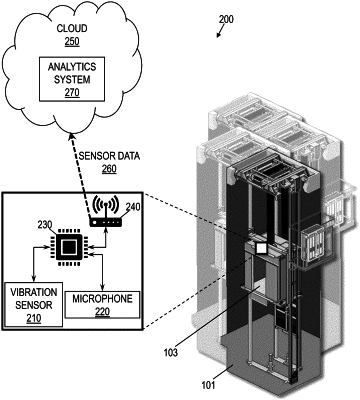| CPC B66B 5/0025 (2013.01) [B66B 1/28 (2013.01); B66B 1/3461 (2013.01); B66B 5/0037 (2013.01)] | 16 Claims |

|
1. A monitoring system comprising:
one or more detection devices configured to generate, at an elevator system, one or more data streams describing a ride of the elevator system and comprising vibration data and audio data, wherein the one or more detection devices comprise a vibration sensor configured to generate the vibration data and a microphone configured to capture the audio data;
a communication device configured to transmit sensor data based on the one or more data streams; and
an analytics system remote from the elevator system, wherein the analytics system is configured to receive the sensor data from the communication device and to determine a ride quality of the elevator system, based on the sensor data;
wherein:
the vibration sensor is configured to be placed in a sleep mode and the active mode, such that the vibration sensor measures vibrations during the active mode but not during the sleep mode, wherein the active mode of the vibration sensor is triggered in response to a first trigger event; and
the microphone is configured to be placed in a sleep mode and the active mode, such that the microphone captures audio during the active mode but not during the sleep mode; wherein the active mode of the microphone is triggered in response to a second trigger event different than the first trigger event, the second trigger event being the detection of no passengers present in an elevator car.
|